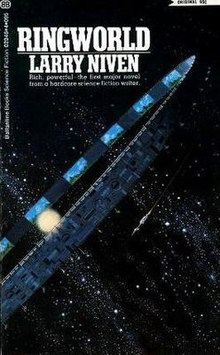Ringworld

Cover of first edition (paperback)
|
|
| Author | Larry Niven |
|---|---|
| Illustrator | Dean Ellis |
| Country | United States |
| Language | English |
| Series | Ringworld storyline from Known Space |
| Genre | Science fiction |
| Publisher | Ballantine Books |
|
Publication date
|
October 1970 |
| Media type | Print (hardcover, paperback), audiobook |
| Pages | 342 pages 102,726 words |
| Awards | Locus Award for Best Novel (1971) |
| ISBN | |
| OCLC | 28071649 |
| Followed by | The Ringworld Engineers, 1980 |
Ringworld is a 1970 science fiction novel by Larry Niven, set in his Known Space universe and considered a classic of science fiction literature. Niven later added four sequels and four prequels. (The Fleet of Worlds series, co-written with Edward M. Lerner provides the four prequels as well as Fate of Worlds, the final sequel.) These books tie into numerous other books set in Known Space. Ringworld won the Nebula Award in 1970, as well as both the Hugo Award and Locus Award in 1971.
The novel opens in 2850 AD on Earth. Louis Gridley Wu is celebrating his 200th birthday. Despite his age, Louis is in perfect physical condition (because of a regimen of boosterspice) but is bored. He has experienced life thoroughly, and is thinking of taking a trip to and beyond the reaches of Known Space, all alone in a spaceship for a year or more. He is confronted by Nessus, a Pierson's Puppeteer, and offered one of three open positions on an exploration voyage beyond Known Space. Speaker-to-Animals (Speaker), who is a Kzin, and Teela Brown, a young human woman, also join the voyage.
They first travel to the Puppeteer home world, where they learn that the expedition's goal is to explore a ringworld: an artificial ring about one million miles (1.6 gigameters) wide and approximately the diameter of Earth's orbit (which makes it about 600 million miles (1,000 gigameters) in circumference), encircling a sunlike star. It rotates, providing artificial gravity that is 99.2% as strong as Earth's gravity through the action of centrifugal force. The ringworld has a habitable, flat inner surface equivalent in area to approximately three million Earth-sized planets. Night is provided by an inner ring of shadow squares which are connected to each other by thin, ultra-strong wire (shadow-square wire).
...
Wikipedia
